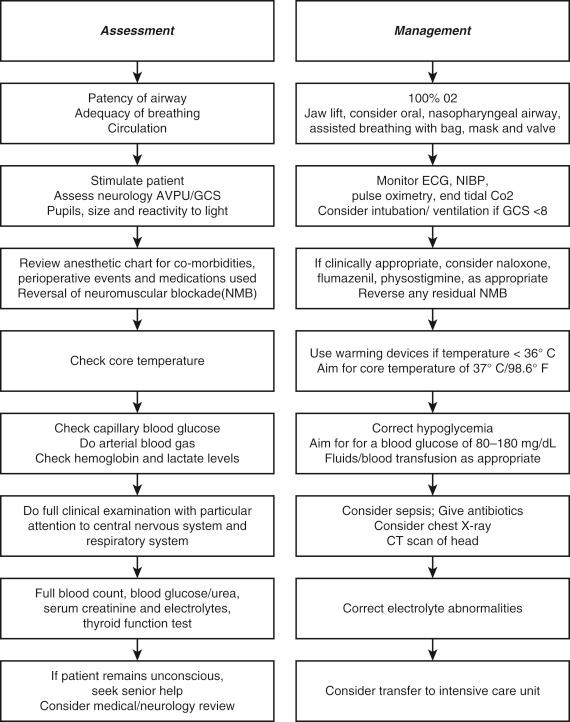Physical Address
304 North Cardinal St.
Dorchester Center, MA 02124
A 65-year-old man undergoes open reduction and internal fixation of a tibial fracture under general anesthesia (GA). He has a history of hypertension and diabetes mellitus. He was on ramipril and metformin. GA drugs included midazolam 2 mg, total intravenous anesthesia with propofol and remifentanil, and he was ventilated on i-gel. Morphine 20 mg was given toward the end of the operation. After 150 minutes of surgery and 20 minutes of removal of i-gel in the postanesthesia care unit (PACU), the patient was still unresponsive to verbal stimuli.
Case Synopsis 2
An 80-year-old woman had a laparoscopic appendectomy under GA. She had a body mass index (BMI) of 35 (weight 95 kg) and mild chronic kidney disease (estimated glomerular filtration rate 55). She had modified rapid-sequence induction with fentanyl 100 μg, propofol 200 mg, rocuronium 50 mg, and anesthesia maintained with sevoflurane in oxygen and air. After 90 minutes of surgery, neuromuscular blockade was reversed, and the patient was extubated. Immediately after that, the patient became unconscious, had shallow respiratory efforts, and had difficulty maintaining oxygenation.
Case Synopsis 3
An 86-year-old woman had fixation of a fractured neck of the femur under GA plus fascia iliaca block. She had hypertension and atrial fibrillation, and was on amlodipine and warfarin. She had a fall at home, and her Glasgow Coma Scale (GCS) score was 14 preoperatively. GA drugs included propofol 100 mg, fentanyl 75 μg, and breathing spontaneously on oxygen/air and sevoflurane through a laryngeal mask airway. After a 45-minute procedure and 30 minutes in the PACU, the patient had not regained consciousness.
There is no universally accepted definition of delayed emergence/recovery after anesthesia. In clinical practice, it is thought to be the failure of the patient to regain the expected level of consciousness within 20 to 30 minutes of the end of anesthetic administration. It may also include abnormal emergence such as severe agitation. The time it takes for full consciousness to recover after anesthesia is influenced by patient factors, anesthetic drugs used, duration of surgery, and interaction between various medications used during the perioperative period. In many patients, it is probably multifactorial with a predominant contribution from one factor.
Common causes of delayed recovery include the following:
Interactions and potentiation of drugs between preoperative medications and anesthetic drugs
Absolute or relative overdose of sedative and anesthetic drugs
Concomitant administration of benzodiazepines and opioids
Sensitivity of patients to drugs (e.g., opioid-naive patients)
Uncommon causes include the following:
Metabolic disorders
Electrolyte disorders
Postoperative delirium
Sepsis
Rare causes include the following:
Serotonin syndrome
Central anticholinergic syndrome
Psychiatric disorders
Stroke and other neurologic complications
Recognition of delayed emergence is usually made by simple neurologic assessments such as AVPU ( a lert, responds only to v erbal stimuli, responds only to p ain, u nresponsive) or the GCS score. It is a diagnosis of exclusion; hence the anesthesiologist must promptly evaluate these patients to diagnose and rule out airway obstruction, respiratory failure, and hypoglycemia to differentiate delayed emergence from life-threatening problems that may falsely manifest as delayed emergence.
The patient should be evaluated immediately with assessment of vital signs after an airway, breathing, circulation (ABC) approach (especially the rate and the character of spontaneous breathing and oxygen saturation) and a physical examination. ABC should be reevaluated throughout the course of delayed emergence. An aid to assessing and managing an unconscious patient is outlined in Fig. 137.1 .

In modern anesthesia with short-acting anesthetic drugs, a majority of the patients recover very quickly after surgery, and most patients are ready to be discharged from the PACU within the first hour. Although delayed emergence has many causes, its predictability and the rate at which it will occur have not been studied well so far. Most case reports are purely anecdotal, and thus no incidence rate has been determined. Though incidence due to long-acting anesthetic drugs may be coming down, actual incidence of delayed recovery may not be, because of patients with complex medical problems on multiple medications having major operations. The cause may also be multifactorial, such as an elderly patient with dementia or renal impairment who has a lengthy procedure under GA. Pharmacologic causes are more likely, especially in the first hour. After the first hour, metabolic, neurologic, and other rare causes are more likely.
Risk factors for delayed recovery include the following:
Elderly
Patients with dementia
Preexisting cognitive or psychiatric disorders
Patients with hepatic and renal impairment
Long operation and anesthesia duration
Longer-acting anesthetic medications
Absolute and relative overdose of anesthetic drugs
Patients on sedative and antipsychotic medications
Intoxicated patients having emergency surgery
Patients physically exhausted before surgery
A majority of patients with delayed emergence recover well. Provided life-threatening problems are rapidly diagnosed and treated, close observation and monitoring will be enough for most patients. Some patients may need unplanned inpatient, high-dependency/intensive care management. Very rarely patients may require surgical intervention, such as evacuation of subdural hematoma, which may initially present as delayed emergence.
Become a Clinical Tree membership for Full access and enjoy Unlimited articles
If you are a member. Log in here